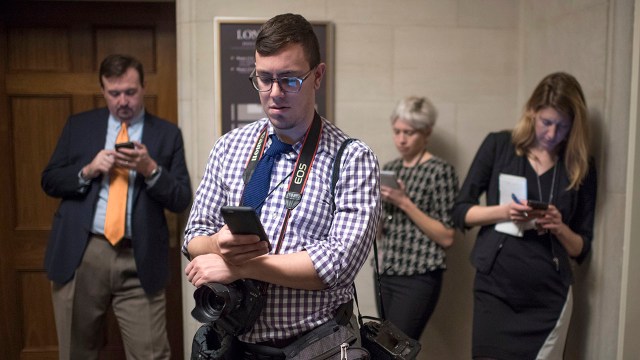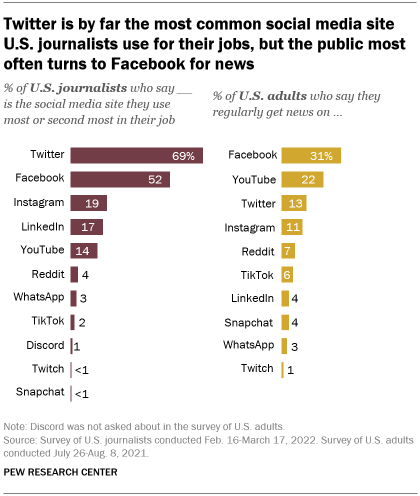
More than nine-in-ten journalists in the United States (94%) use social media for their jobs, according to a recent Pew Research Center survey of reporters, editors and others working in the news industry. But the sites that journalists use most frequently differ from those that the public turns to for news.

Among journalists, Twitter clearly ranks at the top of the list for work-related tasks. Around seven-in-ten U.S. journalists (69%) say it is the social media site they use most or second most for their job. Twitter is followed by Facebook at 52% and, far lower on the list, by Instagram (19%), LinkedIn (17%) and YouTube (14%). None of the other sites asked about in the survey – Reddit, WhatsApp, TikTok, Discord, Twitch and Snapchat – were named by more than 4% of the journalists surveyed.
A different lineup emerges for the public. Among Americans overall, Facebook is the most widely used social media site for news, with 31% of U.S. adults saying they go there regularly for news. YouTube is the second-most frequently used site, with 22% of the public regularly getting news there. Fewer adults (13%) say they regularly get news on Twitter, despite the platform’s widespread use among journalists. Overall, a little under half of U.S. adults (48%) say they often or sometimes get news from social media sites.
The main source of data for this analysis is a Pew Research Center survey of 11,889 U.S.-based journalists who are currently working in the news industry and said that they report, edit or create original news stories in their current job. The survey was conducted online between Feb. 16 and March 17, 2022, by SSRS. Read the appendix for a detailed demographic profile of the journalists who completed the survey.
Because there is no readily available list of all U.S. journalists, Center researchers relied on commercial databases of journalists based in the U.S. as well as supplemental lists of news organizations to create a broad and diverse sample of over 160,000 journalists from as many types of outlets and areas of reporting as possible. Although it is impossible to be certain every segment of the journalism profession in the U.S. is covered by the sample, the use of multiple databases and supplemental lists ensured that journalists from a variety of different reporting areas, news platform types, as well as outlet sizes and types – such as those who work for organizations that are intended to primarily reach a particular demographic group – were represented.
Propensity weighting was used to ensure that the responses of the 11,889 respondents aligned with the full sample of over 160,000 journalists with respect to job titles, media outlet type, freelance status and geographic location.
See topline for the questions asked of journalists in the survey. For more information on the development of the sample of journalists or the survey weighting, please see the methodology.
The figures for the portion of U.S. adults who get news regularly on each social media site comes from a Pew Research Center survey of 11,178 U.S. adults that was conducted July 26 to Aug. 8, 2021. Everyone who completed the survey is a member of the Center’s American Trends Panel (ATP), an online survey panel that is recruited through national, random sampling of residential addresses. This way nearly all U.S. adults have a chance of selection. The survey is weighted to be representative of the U.S. adult population by gender, race, ethnicity, partisan affiliation, education and other categories. Read more about the ATP’s methodology.
See the topline for the questions asked of U.S. adults in the survey, along with responses, and its methodology.
This is the latest report in Pew Research Center’s ongoing investigation of the state of news, information and journalism in the digital age, a research program funded by The Pew Charitable Trusts, with generous support from the John S. and James L. Knight Foundation.
Demographic differences in journalists’ use of social media platforms
Among journalists, the use of social media for work purposes is common across all age groups, but there are differences in the sites that are turned to most frequently.
Twitter is a particular favorite among the youngest journalists, with 83% of those ages 18 to 29 identifying it as one of their most commonly used social media sites. In stark contrast, 45% of journalists 65 and older identify Twitter as one of their top two social media sites for work tasks. Instagram is also more popular among younger journalists (those under 50), while LinkedIn and YouTube are somewhat more popular among older journalists (those ages 50 and older).

Looking at race and ethnicity, Twitter is particularly popular among Asian American journalists, with 82% saying it is one of their most commonly used sites, compared with about seven-in-ten White (69%), Black (70%) and Hispanic journalists (71%). A third of Black journalists cite Instagram as one of the most common sites they use, as do 29% of Hispanic journalists and 24% of Asian journalists – all statistically higher than the 18% of White journalists who say the same.
Differences by the type of news organization journalists work for
The social media sites that journalists use also often vary by the characteristics of the news organizations they work for – including the organization’s original platform, the audience’s political makeup and the geographic focus of the organization’s work.

Journalists who say their organization started in television news stand out in several areas. Two-thirds of journalists in that group say Facebook is one of their most commonly used social media sites – the highest percentage of any platform group and dramatically higher than the 38% of those working at online organizations. Journalists who say they work for organizations that originated on TV are also most likely to include Twitter among their two most relied on sites (80% say this), while print journalists are the least likely to say this (62%). At the same time, television, as well as radio journalists, are less likely than online and print journalists to say LinkedIn is one of their top two sites.
Journalists’ use of social media sites also varies by what they identify as the political composition of their audience. Journalists who say they work at an outlet whose audience leans right politically are much more likely than those with left-leaning audiences to say Facebook is one of their top two social media sites for their work (67% vs. 45%). Conversely, journalists who say their organization has a left-leaning audience are twice as likely as those who say their organization has a right-leaning audience to use Instagram (24% vs. 12%).
The differences for Twitter are not as large, but three-quarters of journalists who say they work at an outlet with a politically left-leaning audience say it is one of the sites they most commonly use, compared with 66% of journalists whose organization’s audience tilts to the right politically.
Among journalists who say they work at a news organization with a community, city or county focus, Facebook is the most commonly used social media platform; 73% say it is one of their top sites. That number plunges to 33% among journalists at organizations with a national focus and to 30% for those working for internationally focused organizations.
Unlike Facebook, LinkedIn is more likely to be used by journalists at nationally or internationally focused news organizations. Around a quarter of journalists at national news organizations (25%) and international news organizations (27%) count LinkedIn among their most frequently used social media sites, compared with only 9% of journalists at community-focused news outlets and 12% of those working at outlets with a statewide focus. (Freelance and self-employed journalists were asked about the geographic focus of their work instead of the geographic focus of their organization’s work.)
Note: Here are the questions asked of journalists for this analysis, along with responses, and its methodology. And here are the questions asked of the U.S. public, along with responses, and its methodology.



